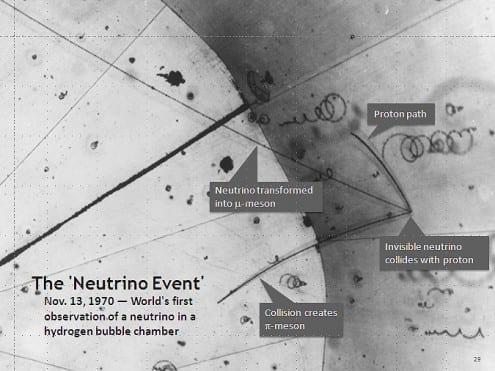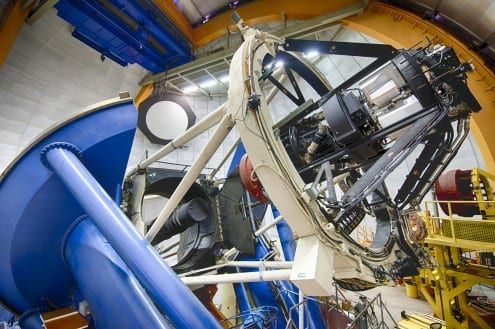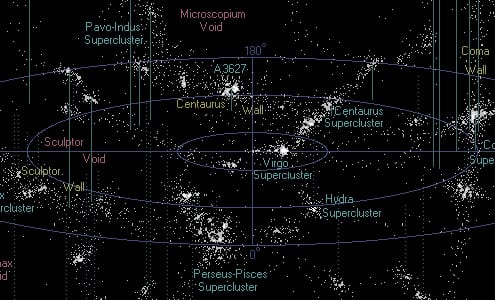Do neutrinos have mass? Anatomy of a scientific debate
By Oli Usher, on 7 August 2014
Do neutrinos have mass? And if so, how much? This apparently simple question has no simple answer and has been the subject of debate, controversy and confusion in the world of physics in recent years.
Neutrinos are subatomic particles created during certain types of nuclear reactions, including those that power the Sun. Although the Sun churns out neutrinos in unimaginably large numbers – around 80 octillion (8 followed by 28 zeroes) pass through the Earth every second – they are very hard to detect. Totally unaffected by electromagnetism, they are invisible and pass through matter unimpeded. They only interact gravitationally and, on the scale of atomic nuclei, through the weak nuclear force.

The first detection of a neutrino in a bubble chamber, in 1970. Photo credit: Argonne National Laboratory (public domain)
The framework of theories scientists use to explain and describe the world of subatomic particles, known as the standard model of particle physics, predicts that neutrinos, like photons, should have no mass. However experimental studies detecting solar neutrinos in recent years contradict this, suggesting that neutrinos do have mass.
So when data shows that a key element of your theoretical framework is proved wrong, what do you do? You could assume that the data are incorrect, or the theory is wrong. The consensus among physicists is that the standard model of particle physics is incomplete – but identifying what is missing from it is a complex issue.
Cosmologists are currently trying to get to the bottom of this question, with sometimes quite radical solutions. Boris Leistedt and Hiranya Peiris, two UCL researchers, have recently ruled out one of these eye-catching theories. The question won’t be settled until new data from a range of physics and cosmology experiments comes in a few years time. (Among these is the Dark Energy Survey, in which UCL is closely involved.)

The Dark Energy Camera on the Blanco telescope in Chile will give new data on the structure and distribution of galaxy clusters in the universe. Photo credit: Reidar Hahn/Fermilab (All rights reserved)
But even before the new evidence comes in, the debate surrounding these claims and counterclaims cast light on how scientific theories develop.
***
The evidence that neutrinos have small (but non-zero) mass is now quite compelling, and scientists are in broad agreement that the standard model needs to be modified or extended to fit this new data. But how much mass they have and how much our theories needs to evolve are still open questions.
Finding the neutrino’s mass isn’t simply of academic interest. The mass of the neutrino is intimately tied up not only with the evolution of the standard model, but with our understanding of key issues in cosmology including the formation of galaxies, the way galaxies are scattered through the universe and the behaviour of the Big Bang.
Some recent studies of cosmological data have made waves this year, proposing a relatively high mass for the neutrino (of around twice the mass of previous estimates). These studies suggested that apparent discrepancies between several large datasets (including temperature fluctuations in the cosmic microwave background, the statistical distribution of galaxies through the universe, and X-ray detections of galaxy clusters) could be explained if neutrinos were heavier than previously assumed.

If the neutrino has a large mass, then several major datasets, including the Cosmic Microwave Background (above) can be reconciled with each other. But just because it is mathematically plausible doesn’t necessarily mean it’s true. Photo credit: NASA (public domain)
Statistically, these studies are quite compelling as they manage to reconcile apparently incompatible data, as well as addressing the key problem of the standard model by ascribing a mass to the neutrino.
But the results, despite tidying up loose ends, have not met with everyone’s approval. In particular, the UCL team think the evidence for neutrinos having such high masses is specious. They have recently published their thoughts on the subject.
They look at this apparent evidence for high-mass neutrinos from two different angles:
- First, if the neutrino is indeed heavy, what would that imply about the universe around us (and does it fit with what we see)?
- Second, if it is not, what else could explain the discrepancies in the data?
On both fronts, they think the evidence points firmly at a significantly lighter neutrino, in line with previous estimates.
***
Assuming that neutrinos have a relatively large mass fits experimental datasets quite well, but, Leistedt and Peiris argue, it is disproved by looking at a broader range of evidence.
The large-scale structure of the universe is dominated by gravity, much of it caused by an exotic (and invisible) type of matter known as dark matter. This governs the distribution, size, shape and motion of galaxies on unimaginably large scales, helping galaxies form, and clustering them together.

This map shows the location of galaxies within about 500 million light years of the Milky Way. Even on this scale – a tiny proportion of the universe – they are clearly bunched together in clusters and filaments. Photo credit: Richard Powell (CC-BY-SA 2.5)
A high mass for the neutrino would upset this balance, and in particular would inhibit the formation of galaxies like the one we live in, meaning there were fewer visible in the sky. It would also mean a less-structured universe on the scale of galaxy clusters and galaxy filaments. This is because very light neutrinos travel very quickly and pass through galaxies and clusters without any significant interaction, leaving them to form under the action of gravity. If neutrinos had higher mass (and hence lower velocities), they would interact far more, diffusing and scattering through galaxies and clusters, changing the way they collapse. In effect they would smear out the distribution of galaxies.
The distribution of galaxies through space seen by astronomers is extremely uneven, with filaments and sheets of galaxies surrounding huge voids, forming a vast cosmic web that fills the known universe. But the web is not consistent with what we would see if the neutrino had a high mass: structure would be washed out, voids would be larger, filaments thinner and galaxy clusters smaller.

Clustering of galaxies, as seen in this Hubble picture, would be much less pronounced if the neutrino had a large mass. Photo credit: NASA, ESA, HST Frontier Fields (public domain)
Moreover, the properties of the cosmic microwave background (the afterglow of the Big Bang) also undermine the idea of a high-mass neutrinos.
So, Peiris and Leistedt say, the models that propose a large mass for the neutrinos, which appear to fit the numbers quite well, turn out not to fit well at all with the individual data sets. The apparent agreement between them, they argue, is not much more than a statistical trick.
As an aside, some experiments have proposed higher-still masses for the neutrino, several times greater than even these controversial calculations. With neutrinos of that sort of mass, it is questionable whether galaxies would have been able to form at all and the universe would have been a dramatically different place.
***
Which brings us to the second question: if the discrepancies between different datasets can’t be explained by a heavier-than-expected neutrino, what does explain them?
Leistedt and Peiris think that this can be answered quite simply: actually most of the data broadly do agree with each other. It is the observations of how common galaxy clusters are in the universe which are out of line. And these are known to be the least robust of them all.
The unreliability, they argue, comes from multiple angles, including the difficulty of proving you have representative sets of galaxy data, the difficulty of knowing whether there is a selection bias in the data (e.g. large galaxy clusters being overrepresented), the difficulty of estimating cluster masses through gravitational lensing, and the extensive modelling involved which involves some degree of educated guesswork.

Gravitational lensing – the bending of the light from distant galaxies – can be used to estimate the mass of galaxy clusters (as the extent of the bending is directly proportional to the amount of mass present). Lensed light from distant galaxies is visible in this closeup of the Hubble picture above as streaks and arcs of light, most obviously the large diagonal streak of bluish light in the right-hand side of the image. But it is fraught with difficulties. Photo credit: NASA, ESA, HST frontier fields (public domain)
Strip this unreliable data out, and it is far from obvious that there even is an anomaly that needs to be explained – and the previous, lighter estimates of neutrino mass look far more plausible once more.
A crucial test of this assumption will come with the Dark Energy Survey, which will bring with it far more robust data on galaxy clusters, alongside measurements of the distribution and gravitational lensing of galaxies, which will cross-check this data. This should, hopefully, settle the controversy. The survey’s five year observing run began last year, with early data expected late in 2015. This early data should be enough to settle the issue, ahead of the final data release in 2017.
***
On one hand, Peiris and Leistedt’s refutation of the neutrino having a large mass seems to bring us back to square one. We still don’t have a terribly clear idea of what the neutrino’s mass is. We still have a hole in the standard model, because even if it is small, the neutrino does have mass. And we have just contradicted some research that appeared to reconcile some of the available facts.
But the practice of science is often like this, with bold predictions, competing claims and imperfect evidence.
And we’re not – quite – back where we started: a plausible theory has been ruled out, we now have a clear hypothesis about why the data had discrepancies, and there will soon be, in the form of the Dark Energy Survey, a tool to test this hypothesis.
The rival teams, at least for now, are sticking by their guns. Leistedt and Peiris think the Dark Energy Survey will prove them right.
Time will tell.
 Close
Close


